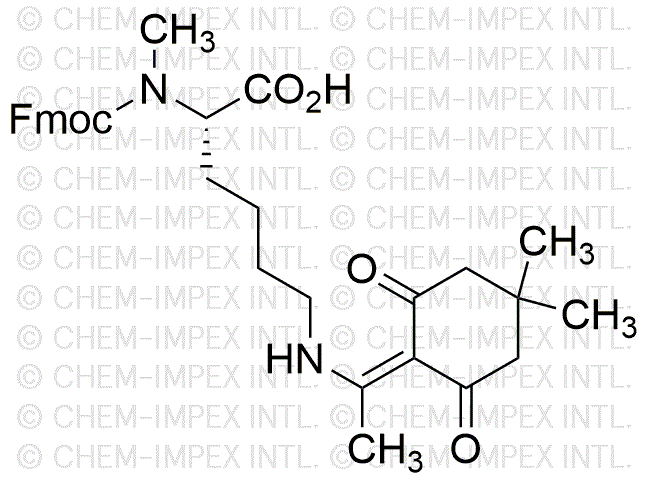Na-Fmoc-Na-Methyl-Ne-1-(4,4-dimethyl-2,6-dioxocyclohex-1-ylidene)ethyl-L-lysine is widely utilized in research focused on:
- Peptide Synthesis: This compound serves as a key building block in solid-phase peptide synthesis, allowing for the creation of complex peptides with high purity and yield.
- Drug Development: Its unique structure aids in the design of novel pharmaceuticals, particularly in targeting specific biological pathways, enhancing efficacy in medicinal chemistry.
- Bioconjugation: It is used to modify biomolecules, facilitating the attachment of drugs or imaging agents to proteins, which is crucial in developing targeted therapies.
- Research in Biochemistry: This chemical plays a role in studying protein interactions and functions, helping researchers understand cellular mechanisms and disease processes.
- Material Science: Its properties contribute to the development of advanced materials, such as hydrogels, which are used in drug delivery systems and tissue engineering.
General Information
Properties
Safety and Regulations
Applications
Na-Fmoc-Na-Methyl-Ne-1-(4,4-dimethyl-2,6-dioxocyclohex-1-ylidene)ethyl-L-lysine is widely utilized in research focused on:
- Peptide Synthesis: This compound serves as a key building block in solid-phase peptide synthesis, allowing for the creation of complex peptides with high purity and yield.
- Drug Development: Its unique structure aids in the design of novel pharmaceuticals, particularly in targeting specific biological pathways, enhancing efficacy in medicinal chemistry.
- Bioconjugation: It is used to modify biomolecules, facilitating the attachment of drugs or imaging agents to proteins, which is crucial in developing targeted therapies.
- Research in Biochemistry: This chemical plays a role in studying protein interactions and functions, helping researchers understand cellular mechanisms and disease processes.
- Material Science: Its properties contribute to the development of advanced materials, such as hydrogels, which are used in drug delivery systems and tissue engineering.
Documents
Safety Data Sheets (SDS)
The SDS provides comprehensive safety information on handling, storage, and disposal of the product.
Product Specification (PS)
The PS provides a comprehensive breakdown of the product’s properties, including chemical composition, physical state, purity, and storage requirements. It also details acceptable quality ranges and the product's intended applications.
Certificates of Analysis (COA)
Search for Certificates of Analysis (COA) by entering the products Lot Number. Lot and Batch Numbers can be found on a product’s label following the words ‘Lot’ or ‘Batch’.
*Catalog Number
*Lot Number
Certificates Of Origin (COO)
This COO confirms the country where the product was manufactured, and also details the materials and components used in it and whether it is derived from natural, synthetic, or other specific sources. This certificate may be required for customs, trade, and regulatory compliance.
*Catalog Number
*Lot Number
Safety Data Sheets (SDS)
The SDS provides comprehensive safety information on handling, storage, and disposal of the product.
DownloadProduct Specification (PS)
The PS provides a comprehensive breakdown of the product’s properties, including chemical composition, physical state, purity, and storage requirements. It also details acceptable quality ranges and the product's intended applications.
DownloadCertificates of Analysis (COA)
Search for Certificates of Analysis (COA) by entering the products Lot Number. Lot and Batch Numbers can be found on a product’s label following the words ‘Lot’ or ‘Batch’.
*Catalog Number
*Lot Number
Certificates Of Origin (COO)
This COO confirms the country where the product was manufactured, and also details the materials and components used in it and whether it is derived from natural, synthetic, or other specific sources. This certificate may be required for customs, trade, and regulatory compliance.


